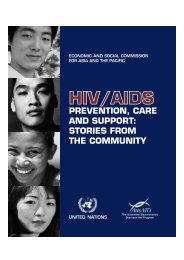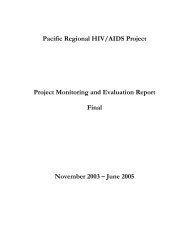Behavior Change Communication (BCC) for HIV/AIDS - hivpolicy.org
Behavior Change Communication (BCC) for HIV/AIDS - hivpolicy.org
Behavior Change Communication (BCC) for HIV/AIDS - hivpolicy.org
Create successful ePaper yourself
Turn your PDF publications into a flip-book with our unique Google optimized e-Paper software.
• Knowledge change: an increase in knowledge among targeted youth of modes of transmission<br />
• Attitude change: an increase in perception of personal risk or a change in authorities’ attitudes toward<br />
promoting condoms to youth<br />
• Environmental change: a decrease in harassment of sex workers by police or an increase in acceptance<br />
of messages about condom use on television<br />
Although some of these changes are not directly related to behavior change, they can function as necessary<br />
environmental antecedents or as shifts that reflect an increasingly supportive environment.<br />
An effective <strong>BCC</strong> strategy needs to be developed to guide achievement of intermediate and longer-term<br />
outcomes. Examples of <strong>BCC</strong> objectives are:<br />
• Increased demand <strong>for</strong> in<strong>for</strong>mation about <strong>HIV</strong> and <strong>AIDS</strong>. (Youth will ask <strong>for</strong> in<strong>for</strong>mation about <strong>HIV</strong> and<br />
<strong>AIDS</strong>.)<br />
• Increased knowledge about <strong>HIV</strong> and <strong>AIDS</strong>. (Youth will have correct knowledge of modes of<br />
transmission of <strong>HIV</strong> and <strong>AIDS</strong>.)<br />
• Increased self-risk assessment. (Truck drivers will say that if they do not use condoms they feel at<br />
increased risk of contracting <strong>HIV</strong>.)<br />
• Increased demand <strong>for</strong> in<strong>for</strong>mation on STIs. (Miners will ask <strong>for</strong> more in<strong>for</strong>mation on STIs.)<br />
• Increased demand <strong>for</strong> services. (Sex workers will demand VCT services.)<br />
Develop themes and messages<br />
It is important to develop an overall theme that will appeal to and attract target populations. The theme<br />
should stem from the <strong>BCC</strong> <strong>for</strong>mative assessment and further consultation. The theme will provide overall<br />
guidance <strong>for</strong> the development of messages, all of which will there<strong>for</strong>e be consistent with the theme.<br />
The theme should be positive. It is now commonly understood that fear campaigns and campaigns blaming<br />
particular groups are ineffective. Most experts agree that fear tends to focus an audience’s attention on what<br />
not to do, or what to avoid. Approaches are more effective when they promote positive messages that state<br />
clearly what audiences can and should do.<br />
Themes should also avoid blaming or stigmatizing. Messages that blame a particular group can backfire,<br />
especially in <strong>AIDS</strong> programs, by diverting audiences’ attention from their own needed behavior changes.<br />
Such messages can also encourage discrimination, stigma and even physical harm to PLHA and other<br />
vulnerable groups. Stigma and denial can in turn cause people to avoid services that may benefit them.<br />
The theme should call attention to the campaign and link its various elements together, functioning as a sort<br />
of umbrella. It should be catchy and devised in such a way that all target populations can relate to it and<br />
identify with it. People who see different messages <strong>for</strong> different audiences should be able to link any of these<br />
diverse elements with the theme of the campaign.<br />
Effective prevention and care messages should diplomatically “push the envelope,” if necessary, and, to avoid<br />
conflict, take into account the country’s traditions, culture, norms and values.<br />
A message consists of carefully crafted in<strong>for</strong>mation that is targeted at specific population groups. It should be<br />
designed to meet <strong>BCC</strong> objectives and to stimulate discussion and action. Messages are the most critical<br />
element in developing a <strong>BCC</strong> strategy—and they are the area where most strategies fail.<br />
14











